A lively collection of ghost stories from the seventeenth century to the present. Britain is full of ghostly stories – from the wraith of John Donne’s wife to the Cock Lane poltergeist. Gillian Bennett has collected together the 100 best tales told to frighten and enthral over the last four centuries. Famous hauntings and familiar legends are combined with unusual and long-lost accounts of apparitions, boggarts, black dogs and ‘unhappy houses’ in this new collection.
New Books and Media
The 100 Best British Ghost Stories, by Gillian Bennett
Publish Date: August, 2012

Ghosts are Real: Images from the Beyond, by Hugh Fairman and Tina Laurent
Publish Date: July, 2012

From the authors: The idea contained within this book is that what humankind calls ghosts or spectres are in fact a manifestation of a fundamental aspect of nature that is for the most part very much hidden from our everyday viewpoint, but that is perfectly explicable in itself. Indeed once the mechanisms are understood there is nothing very mystical or very mysterious about these phenomena. In order to demonstrate this fact the book contains some 500 digital camera images that show certain patterns which provide pictorial evidence for the intellectual ideas which are described in the text. These images, (that we happen to call para-pics, a shortened version of paranormal pictures), have been captured by a life-long psychic (TL) using certain specialised techniques.
Seriously Strange: Thinking Anew about Psychical Experiences, edited by Sudhir Kakar and Jeffrey J. Kripal
Publish Date: July, 2012

From the publisher’s website: This book sheds light on some of the most baffling paranormal experiences. It maps the mind-bending geography of the human psyche and the spectrum of experiences that influence it. The book features accessibly written essays by the most eminent scholars in a field constantly sullied by frauds and dismissed by sceptics. The paranormal has exerted a strange fascination over humankind for centuries. In Seriously Strange, the second volume in the Boundaries of Consciousness series edited by Sudhir Kakar and Jeffrey D. Kripal, a group of nine intellectuals come together to shed light on some of the most baffling experiences on record of psychical experiences. Through these illuminating essays, they tell us how such extraordinary events can be decoded and interpreted to become the object of rigorous scientific study.
The range is wide: from essays that reveal how Freud and Jung engaged with the notion of the paranormal to a provocative and humorous memoir of a physicist who spent over a decade running a secret psychic spying programme for the US government during the Cold War (Edwin C May ran a secret psychic spying programme, known as Star Gate, for the US government. He recounts the project’s successes, as he sees them. May is perhaps the world’s only person who has enjoyed a 20-year, full-time job with industrial wages plus health and retirement benefits in which his only responsibility was Extra Sensory Perception [ESP] research and its applications). There are also heartfelt accounts by practising psychiatrists who recount the dramatic effects of the anomalous in their healing practice to a learned call for the renewal of professional parapsychology in the light of Patanjali’s Yoga-sutras. By telling their own stories and exploring some of the implications of their work, these men and women throw light on the spectrum of experiences such as love and death, desire and sex, hurt and healing, myth and magic that influence the human psyche. By telling their own stories and exploring some of the implications of their work, these men and women map the mind-bending geography of the human psyche and the spectrum of experiences, love and death, desire and sex, hurt and healing, myth and magic, that influence it.
The Ashgate Research Companion to Nineteenth-Century Spiritualism and the Occult, edited by Tatiana Kontou and Sarah Willburn
Publish Date: July, 2012
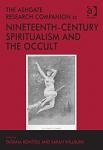
Haunted Hostelries of Shropshire, by Andrew Homer
Publish Date: June, 2012

From the publisher’s website: Haunted Hostelries of Shropshire offers a fascinating insight into some of Shropshire’s most haunted pubs, inns, hotels and licensed establishments. It comes as no surprise that the dramas and tragedies played out over the years within the walls of these properties should result in such convincing accounts of ghostly activity. Within these pages you will find many new stories of hauntings, together with a fresh look at some of the more traditional tales. An overriding theme throughout this book is the sheer amount of seemingly paranormal activity which is regularly being experienced by both staff and customers alike. You will discover accounts of phantom children, poltergeists, spectral animals, a cheeky bottom pinching ghost and how a jealous highwayman from long ago still makes his presence felt. Find out which haunted rooms to stay in, or indeed avoid for an undisturbed night’s sleep. The majority of these haunting stories have been gathered at first hand from the people who have experienced the phenomena for themselves. Visit the licensed properties included here for yourself and who knows, perhaps you will have a ghostly experience to add to the rich heritage of Shropshire’s haunted hostelries.
Natural and Supernatural: A History of the Paranormal from Earliest Times to 1914, by Brian Inglis
Publish Date: June, 2012
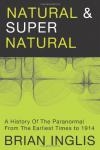
From the publisher’s website: Did Moses turn rods into serpents? Does Uri Geller bend spoons? Did Socrates and Joan of Arc have spirit guides? Did Daniel Home levitate? The 1970’s provided a striking revival of interest in the paranormal which has continued unabated into the twenty first century. Telepathy ESP, clairvoyance, premonitions, and psychokinesis – the action of mind upon matter – it was not long ago that orthodox opinion, both scientific and religious, rejected the possibility of such things out of hand. Today, their reality has been demonstrated and tested in laboratories all over the world and the results are published in serious scientific journals. Natural and Supernatural is the first full survey of the subject for over a century. With scrupulous thoroughness and a wealth of extraordinary detail, Brian Inglis presents his evidence, drawing on anthropological studies of primitive tribes and records of classical antiquity and taking his story to the outbreak of the First World War, when the first phase of scientific psychical research came to an end. He pays particular attention to the work of the mesmerists and of the early psychical researchers in the last century. He deals, too, with related aspects such as hauntings, poltergeist outbreaks, scrying and dowsing. Contrary to popular belief, the evidence for psychic phenomena and non-locality, and the mass of material available to researchers is huge. Inglis meticulously sifted the genuine from the false, singling out such episodes as may reasonably be identified as historical and allowing the reader to make up his own mind, on the basis of the fullest and soundest knowledge, whether to accept paranormal phenomena or not. If they are accepted – and informed opinion is more and more moving that way – then a real revolution in our way of thinking is due to follow. For if mind can communicate with mind at distance, or move objects without contact, not merely will there have to be extensive revision of science textbooks. History, too, will need to be re-written, to allow for the possibility that reports which have long been dismissed as myth or illusion may have been accurate after all. The implications of the subject are great, and Inglis does them full justice.
Paranormal County Durham and Haunted Carlisle, by Darren W. Ritson
Publish Date: June, 2012

Paranormal County Durham From the publisher’s website: County Durham, also known as ‘the Land of Prince Bishops’, is an area of outstanding beauty primarily recognized for its lead mining and its farming industries. With a combination of rolling hills, quaint little countryside villages, townships and a historic city as its capital, County Durham is a stunning region. The ghosts here are aplenty and they are festooned far and wide. We have ghostly galloping steeds and harrowing horseman silently making their way across the moors and hilltops; priests, monks and god-fearing men eerily frequent the many religious buildings that are scattered hither and thither around the county; poltergeists plague people and their places; old pubs and inns are bursting at the seams with long-dead patrons and ancient battles once fought here are being silently fought again much to the bewilderment of those that see them or indeed, hear them. So wherever you endeavour to go in the wonderful County Durham, whichever way you turn, you can be sure a ghost will lurk in almost every corner. Haunted Carlisle From the publisher’s website: This new book contains a chilling collection of eyewitness accounts and terrifying tales from in and around Carlisle which is sure to appeal to everyone interested in the supernatural history of the city. Illustrated with over 60 pictures, these spooky stories include the headless spectre of Carlisle railway station, the phantom boy of Corby Castle, and the ghostly highwayman of Barrock Park, among many others. For those who dare to read it, Haunted Carlisle is guaranteed to make your blood run cold. DARREN W. RITSON is a paranormal investigator and author who has studied the ghosts and legends of northern England for over twenty years. He is a member of the Incorporated Society of Psychical Research and regularly contributes articles to Paranormal Magazine, amongst others. His previously published works include The South Shields Poltergeist, Haunted Newcastle, Haunted Berwick, Haunted Durham and Ghosts at Christmas. He lives in Howden, North Tyneside.
The Science of Ghosts: Searching for Spirits of the Dead, by Joe Nickell
Publish Date: June, 2012
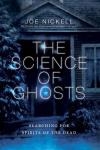
From the publisher’s website: From the most ancient times, people have experienced apparent contact with spirits of the dead. Some have awakened to see a ghost at their bedside or encountered a spectral figure gliding through a medieval castle. Others have seemingly communicated with spirits, like the Old Testament’s Witch of Endor, the spiritualists whose darkroom séances provoked scientific controversy in the last two centuries, or today’s “psychic mediums,” like John Edward or Sylvia Browne, who seem to reach the “Other Side” even under the glare of television lights. Currently, equipment-laden ghost hunters stalk their quarry in haunted places—from urban houses to country graveyards—recording “anomalies” they insist cannot be explained.
Putting aside purely romantic tales, The Science of Ghosts examines the actual evidence for such contact—from eyewitness accounts to mediumistic productions (such as diaphanous forms materializing in dim light), spirit photographs, ghost-detection phenomena, and even CSI-type trace evidence.
Offering numerous exciting case studies, The Science of Ghosts engages in serious investigation rather than breathless mystifying. Pseudoscience, folk legends, and outright hoaxes are challenged and exposed, while the historical, cultural, and scientific aspects of ghost experiences and haunting reports are carefully explored. The author—the world’s only professional paranormal investigator—brings his skills as a stage magician, private detective, folklorist, and forensic science writer to bear on a topic that demands serious study.
Are ghosts real? Are there truly haunted places, only haunted people, or both? And how can we know? Taking neither a credulous nor a dismissive approach, this first-of-its-kind book solves those perplexing mysteries and more—even answering the question of why we care so very much.
Tales of the Supernatural (DVD), by Andrew Gray (producer and director)
Publish Date: May, 2012
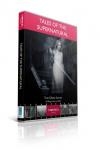
From the publisher’s website: Whether you believe in them or not there is no doubt that tales of ghosts, strange happenings and things that go bump in the night are stories that we love to hear. This spooky film includes eye-witness accounts of the girl who communicates with the dead, a phantom figure captured in a photograph and the unexplained story of the church bell that rings itself. Prepare to be chilled and disturbed as you venture into a world of haunted police stations and ghosts of Cambridge Colleges.
Click here for further information.
Ghosts & Gallows, and Haunted Luton and Dunstable, by Paul Adams
Publish Date: May, 2012
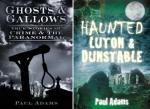
From the publisher’s website:
Ghosts & Gallows: Murder and ghosts go hand-in-hand and vengeful spectres seeking justice or haunting the scene of the crime or their killers have adorned the pages of literature since before Shakespeare.
This chilling collection of true-crime tales dating from the mid-eighteenth century to the present day all feature some element of the paranormal. Gathered from across the UK, cases include the discovery of a body by a spiritualist medium, a murder solved by a dream of the mother of the victim, and evidence at a Scottish murder trial provided by the ghost of the victim herself. Featuring visions, psychometry, ghosts, haunted prisons, possessions, and spiritualist detectives, this book is a fascinating look at criminology and ghost hunting.
Paranormal historian Paul Adams has opened the case files of both the criminologist and the ghost hunter to compile a unique collection of crime from British history. No true-crime bookshelf is complete without Ghosts & Gallows.
Paranormal Luton and Dunstable: The paranormal histories of Luton and Dunstable are brought vividly to life in this, the first dedicated guide to the haunted and mysterious sites of these two unassuming Bedfordshire towns.
Paranormal historian Paul Adams opens case files both ancient and modern to compile a chilling collection of supernatural experiences, ranging from apparitions on lonely Galley Hill and the phantom Dunstable hitch-hiker to the haunted corridors of the doomed Alma Theatre and the ghostly knights of Someries Castle. Richly illustrated and full of first-hand accounts, it will fascinate anyone with an interest in the unexplained.
Paul Adams has been interested in ghosts and the paranormal since around the age of eight. He studied the Borley Rectory case for many years, and co-authored the definitive study, The Borley Rectory Companion, with Peter Underwood and Ed Brazil in 2009. He lives in Limbury, Luton.
Haunted Girl: Esther Cox and the Great Amherst Mystery, by Laurie Glenn Norris with Barbara Thompson
Publish Date: May, 2012
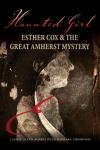
From the publisher’s website: In 1878 eighteen-year-old Esther Cox arrived in Amherst, Nova Scotia, to live with her sister’s family. Shortly after Esther moved in, the story goes, the house was plagued by unexplained occurrences—something (or someone) knocked on the walls, hid household items, moved furniture around, and set fires. Esther herself was subject to mysterious fevers, prodding and, on one occasion, stabbing. These occurrences followed her when she went to stay with other families in the area. Eventually she was charged with robbery and spent a month in jail, after which the haunting ceased.
Was Esther the victim of paranormal powers or the troubled mind behind a series of elaborate hoaxes? At the time of her alleged haunting, the plausibility of Esther Cox’s claims were hotly debated in newspapers and by fellow Amherst residents. In the hundred years since her death, Esther’s story has been retold numerous times and she remains to this day the town’s most famous historical figure.
Includes 30 photos of key locations in Amherst related to the story as well as Esther's family members.
Please see publisher’s website for further details.
Muckraker: The Scandalous Life and Times of W T Stead, Britain’s First Investigative Journalist, by W. Sydney Robinson
Publish Date: May, 2012

From the publisher’s website: A major work by a brilliant young biographer, Muckraker details the tenacity and verve of one of Victorian Britain’s most compelling characters. Credited with pioneering investigative reporting, W. T. Stead made a career of ‘muckraking’: revealing horrific practices in the hope of shocking authorities into reform. As the editor of theNorthern Echo, he won the admiration of the Liberal statesman William Gladstone for his fierce denunciation of the Conservative government; at the helm of London’s most influential evening paper, the Pall Mall Gazette, he launched the career-defining ‘Maiden Tribute’ campaign. To expose the scandal of child prostitution, Stead abducted thirteen-year-old Eliza Armstrong (thought by many to be the inspiration behind Eliza Doolittle, from friend George Bernard Shaw’s Pygmalion), thrusting him into a life of notoriety.
Labelled a madman in later life for dabbling in the occult, W. T. Stead conducted his life with an invincible zeal right up until his tragic demise aboard the Titanic. Revealing a man full of curious eccentricities, W. Sydney Robinson charts the remarkable rise and fall of a true Fleet Street legend in this enthralling biography.

